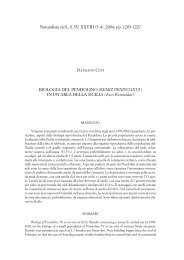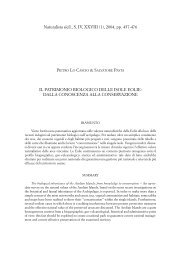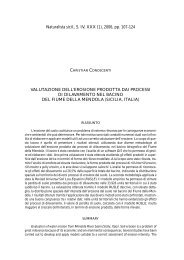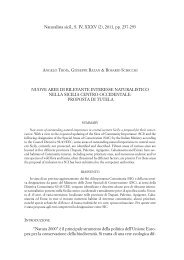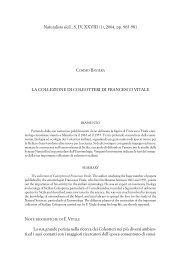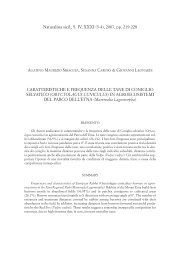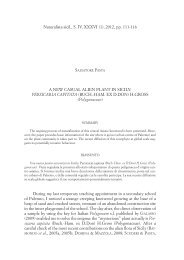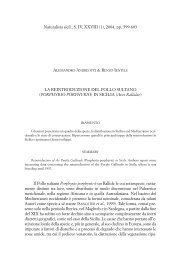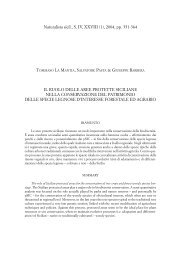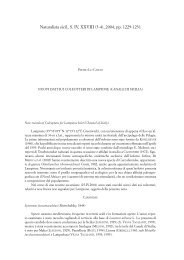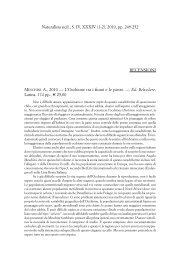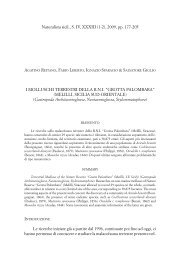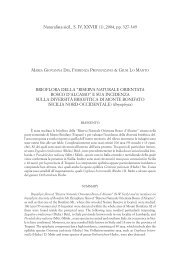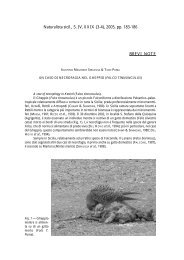2007,pp - Società Siciliana di Scienze Naturali
2007,pp - Società Siciliana di Scienze Naturali
2007,pp - Società Siciliana di Scienze Naturali
You also want an ePaper? Increase the reach of your titles
YUMPU automatically turns print PDFs into web optimized ePapers that Google loves.
Gall midges (Diptera Cecidomyiidae) of Sicily<br />
275<br />
develops a year; adults emerge in spring. Females lay eggs in the unopened<br />
blossoms. Up to 100 larvae were observed in a single fruit. Fully developed larvae<br />
leave fruits, drop to the ground and overwinter in the soil. DARVAS et al.<br />
(2000) classify this species as a major pest of pears. Occurrence: DE STEFANI<br />
(1917) recorded it in Sicily without giving a locality. Distribution: primarily<br />
European species, introduced in North America, Australia, Japan and China.<br />
Contarinia quercina (Rübsaamen, 1890)<br />
Larvae develop among small young leaves of the terminal leaf bud of<br />
Quercus robur L., Q. petraea (Matt.) Liebl. and Q. pubescens Willd.<br />
(Fagaceae). Two generations develop a year. Occurrence: recorded from Sicily<br />
by DE STEFANI (1906c) on Q. pubescens (incorrectly as C. quercicola, which<br />
is associated with Q. cerris). Distribution: European.<br />
Contarinia tritici (Kirby, 1798)<br />
Yellow larvae develop gregariously in the spikelets of Triticum aestivum<br />
L. (T. vulgare Vill., T. sativum Lam.) (Poaceae). Only one generation develops<br />
per year. Larvae feed quite hidden on the developing flower organs; as a<br />
result no grain develops. Mature larvae drop in the ground and spin a<br />
cocoon in the soil where they hibernate. In Central Europe adults emerge<br />
from May to June accor<strong>di</strong>ng to climatic con<strong>di</strong>tions. DARVAS et al. (2000) evaluate<br />
it as a serious pest of wheat in Europe. Occurrence: MINÀ PALUMBO<br />
(1882) reported this species from Sicily. Distribution: Euro-Asian species<br />
occurring, sometimes quite hidden, in many countries of Europe and known<br />
in several parts of Asia. It has been introduced into North America<br />
(SKUHRAVÁ et al., 1984a, 1984b).<br />
Contarinia viticola Rübsaamen, 1906<br />
Larvae develop in swollen flower buds of Vitis vinifera L. (Vitaceae)<br />
and hibernate in the soil. Only one generation develops a year. This species<br />
was relatively abundant in Central Europe at the beginning of 20 th century<br />
and <strong>di</strong>sa<strong>pp</strong>eared after grapes had been treated with sulphur. Occurrence: DE<br />
STEFANI (1917) recorded it in Sicily without giving a locality. Distribution:<br />
European.<br />
Cystiphora sonchi (Bremi, 1847)<br />
Larvae cause pustule galls on leaves of Sonchus oleraceus L. and S. asper<br />
L. (Hill) (Asteraceae) (Pl. II, Figs. 8 and 9). Several generations develop during<br />
vegetative season. Larvae leave galls and pupate in the soil. Occurrence:<br />
even if this species was not recorded explicitly, DE STEFANI (1905a) wrote that



